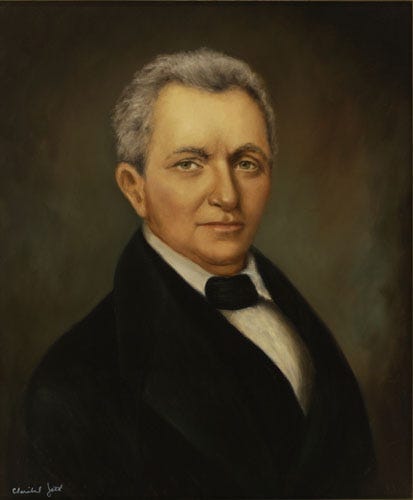Ever wonder about the completely inconvenient location of Florida’s capital, far removed from the state's population centers? It’s a minimum of seven hours to reach by car from Miami and slightly less from Tampa Bay or Orlando. The answer is good, old-fashioned Florida bullfuckery.
After the US started formally occupying Florida in 1821, fully becoming a territory the following year, the location of where the government’s business was done required resolution. With only two cities to speak of, each of which served as the capital of East and West Florida, respectively, sharing the locations for legislative sessions was the first solution. Legislators would travel from Pensacola to St Augustine on alternating years or vice versa. Both of these locations seem inconveniently remote by today’s standards, but at the time, there were few, if any, population centers south of present-day Ocala. The peninsular part of the state remained largely uninhabited by white people, who were the only people who mattered in the eyes of Americans at that time.
As if traveling Interstate 10 between the two places in modern times isn’t torturous enough, in the 1820s, the trip took 28 days by land, or over a month by sea. There was a sizable death toll by misadventure or drowning amongst the early legislators who traveled to do the government’s work. William Pope DuVal, the first civilian governor of the territory, had his hands full trying to sort out the messes left to him by the previous military governor, Andrew Jackson. Among them was finding a reasonable solution to the body count of elected officials. It seemed appropriate to find a suitable location equidistant from the two capitals.
Commissioners John Lee Williams of Pensacola and Dr. Willam H Simmons of St Augustine met in the middle and were instantly struck by the land around present-day Tallahassee. Partly because it didn’t look like Florida at all, they were enamored with the quality and quantity of cotton, sugar cane, and vegetable crops that were well-tended there. Tallahassee sits on a different substrate than the limestone that underlies most of Florida. This geologic difference made for rolling hills, and the area surrounding later became known as “the cotton counties.” Other folks liked the area, as well. That’s why they lived there. They were responsible for the verdant crops that were so alluring. But Williams and Simmons did not let that small matter deter them.
Enemathla was a man of Creek descent who acted as the leader of a village of people called Tallahassee (Tallassee). He welcomed Williams and Simmons into his town and entertained them with Native sporting events and a giant feast. After happily partaking in his kindness, the two commissioners thanked Enemaltha by telling him that they really, really, liked his land and were going to take it from him – because white makes right.
Enemathla wanted a diplomatic compromise, telling the two that the area around him was largely unpopulated. They could have their pick of multiple, better places for their new city. After pretending to evaluate other areas, Williams and Simmons returned and said, “Yeah, no. We like your place.” Enemathla balked.
In September of 1823, DuVal called for all of the Native leaders to gather at Moultrie Creek, south of St Augustine, for a meeting of great import. Over 350 non-white leaders gathered there for what they assumed was an opportunity to address land grievances. In the absence of a centralized system of governance, they elected Enemaltha to speak for them.
In their treaty with Spain, the US agreed to convey to the inhabitants of Florida the enjoyment of “all the privileges, rights, and immunities of the citizens of the United States.” What the Seminole received upon their arrival instead was an ultimatum that stripped them of all human and property rights. With a handful of exceptions, all non-whites were to relocate to the undesirable and uninhabited land south of Alachua (Payne’s) Prairie. The Seminole left pleading that at the very least their children be allowed to learn to read and write. In making this treaty, DuVal was able to shift the cost and responsibilities of relocation to the federal government and not burden those who would benefit from the ill-gotten gains.
Enemaltha returned home, awaiting compensation for his land that would never come. As speculators arrived in his home and built the capital city around him, he refused to leave. He spoke with other leaders and announced that he would not honor the treaty until DuVal personally spoke with him.
Two of the worst people to ever happen to Florida, Caroline Mays Brevard and Washington Irving, sought to diminish Enemaltha. In their tellings of this meeting, portraying him as a haggard, sullen old man, unfit for leadership, they claimed Enemaltha was easily trounced by our hero DuVal in this meeting, slinking off in disgrace. In truth, Enemaltha was considered charismatic, “honest and bold, of strong character.” However, the outcome was the same - DuVal forced Enemaltha and his people to vacate their lands. At least DuVal was kind enough to retain the place's name after the people he subjugated. It was the first of many towns and subdivisions throughout the state to be named for what once was there.
Ironically, DuVal’s legacy of corruption crumbled down on him. He lit out to Texas to join his sons, where he lived out his days as a lawyer of mediocre reputation. That’s the part of the brave governor’s story that Brevard neglected to tell.



